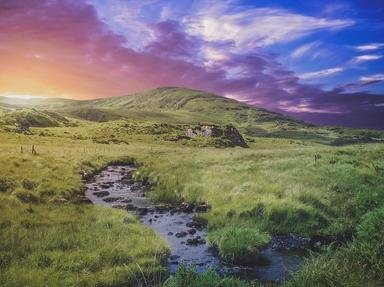Quiz Answer Key and Fun Facts
1. One of the best-known battles in Ireland took place in 1690 and was to shape the destiny of several European nations. On which river did it take place?
2. The Irish had been fighting among themselves for hundreds of years before forces from nations in Europe turned their attention to the Emerald isles. From the ninth century on, which group of people posed a threat to the native Irish peoples?
3. In the 10th Century, a decisive battle took place between Irish warlords and the forces of an invading people. Which battle paved the way for the Irish to gain control of the city of Dublin from the invaders?
4. By the latter part of the 12th century, Ireland seemed to have adapted to a settled if uneasy system of kingships. In 1169, though, one usurped king invited in a force of Norman mercenaries to help regain his throne. This began the Norman invasion of Ireland. Which king of England supported the intervention?
5. For centuries, Ireland was a place of war and many lives were lost during the long list of battles and sieges. In December 1688 the first major clash in a new episode of conflict began with the siege of a northern town. Which of these was it?
6. While Ireland had many battles between its own peoples, it was at times part of pan-European wars and campaigns. In 1760 the town of Carrickfergus was a bit-player in the wider scheme of things. Which nation seized the town and held it for five days?
7. By the early part of the 1700s, England could claim to rule over the island of Ireland. Local peoples were appeased, or replaced by settlers brought in from Scotland and England. These were largely Protestants who displaced the local Catholic landowners. In 1798, a concerted effort to overthrow British rule was mounted. Which group led the 1798 rebellion?
8. After 800 years of dominancy over Ireland, English/British rule was threatened by a rebellion that was to lead eventually to the ending of that rule over a major part of the island. At what time of year in 1916 did that rising take place?
9. In 1921, a treaty was signed between Great Britain and Irish nationalists to establish a new "Free State" in 26 of Ireland's 32 counties. That might have been expected to bring about peace after a bloody rebellion, but instead a civil war ensued between differing groupings as they jockeyed for power. In 1922, one of the leaders of the war of independence was ambushed and shot dead by rival forces. Who was he?
10. Ireland and Great Britain had a fractious relationship over a period of 800 years. Which British leader's actions were considered to be particularly heinous by the Irish?
Source: Author
darksplash
This quiz was reviewed by FunTrivia editor
bloomsby before going online.
Any errors found in FunTrivia content are routinely corrected through our feedback system.
